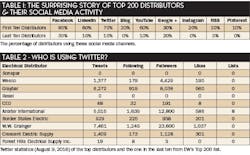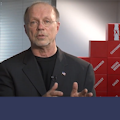Social media is interesting. An engineer friend (very smart) thinks it will destroy the world. When I asked why, he said because there is so much B.S. on it. “So you mean there wasn’t B.S. before social media?” I asked. He got quiet, then said, “But now you can see it.”
B.S. aside, social media is one of the channels distributors have to consider when building their brand. How do I know this? Electrical Wholesaling’s Top 200 list. Consider Table 1 (below).
Eighty percent of the 10 largest Top 200 distributors are using Facebook and LinkedIn links on their website, compared to 30% and 10% respectfully of the last ten. And while the argument doesn’t necessarily mean you will grow your brand or business via social media, the biggest distributors are leaving nothing to chance — it’s obvious that the larger firms are “all in.” However, they are not “all in” at the same rate.
When EW’s Jim Lucy suggested that I write an article on the topic of using Twitter to grow your brand and business, I got excited. Twitter has become an extension of any business, and I love Twitter. In fact, you can’t listen to the news anymore without someone quoting a tweet. Twitter is changing the way we communicate. The question for businesspeople, however, is how does it help your brand and business? Does it help? The short answer is, yes. Let me prove it.
Lesson #1: Social media isn’t all talk — It’s about listening, too. My engineer friend didn’t like social media because of what he heard on the channels. But in your own business, you hear a lot of things, and social media is no different. Listening is one of the most overlooked benefits of social media, and guess what — your customers are talking on them. What you have to do to reach them is listen.
Examining Table 2 shows some other interesting things. For example, Grainger has 23,600 followers, the most of EW’s list of Top 10 Electrical Distributors. Yet, CED (ranked higher) has only 191. What does that mean in our analysis of Twitter building a brand and your business?
It means that CED is just starting to investigate the Twitter channel (note they only tweeted 48 times). Check their Twitter account six months from now, and I bet you will find them in the thousands of followers! Hint: their late entry is an advantage for companies who are already invested in the channel!
Lesson #2: It’s about the customer experience. One of my clients many years ago said in a discussion about brand and business, “I want to know if their building is good enough for my product.” He was wrong then, and he would still be wrong today. The value proposition is not about your product — it’s about what the customer needs, and the customers of today are communicating via these channels. Just ask your children. Just notice when someone tweets something on a brand that’s negative, how that brand may react.
I am not suggesting that you abandon traditional marketing tactics like advertising and public relations or direct mail. The suggestion is that these social channels aren’t going away, and you had better pay attention to them and integrate them to your traditional work. For example, consider who brands follow — and who follows the brands. In Twitter, you can see both groups and then learn from the choices to shape some interesting tactics of your own.
Greg Martini (@GregMartiniNC) is following Graybar. He has only tweeted seven times. But, he works at TE Connectivity, a leading connectivity and sensor solutions company — and actually a $12 billion global technology leader. He’s new to Twitter. Should he be your customer? You can reach him in Twitter easier than you think.
Jimi Barker (@jimibarker2) also follows Graybar. He has tweeted 335 times, and is director of sales for US Connec, a leader in providing passive components for high density optical interconnects. Should you pitch him? You can tweet him. If you follow him, and he follows you back, you can direct message him.
The world is a big place, and social media actually helps you narrow it. By exploring the channel, you can find out that (@TheBoeingCenter) is also following Graybar. The Boeing Center is a world-class research center that disseminates knowledge on global supply chain management, operational excellence and risk management. Isn’t that the business you are in?
I’ve randomly selected Graybar, but you can do this with any company using Twitter. And, they can do it to you. That’s why who you follow is important. Many of these distributor brands follow manufacturers, using the Twitter channel to stay current on what the manufacturer is saying. Yet besides manufacturers and media outlets like EW, looking at who distributors follow can give us ideas on customer engagements themselves.
For example, in examining the followers of one of the top ten, you can find the regional marketing manager for ABB, the director of commercial marketing at Hubbell, and the marketing director for Panasonic, among others. Are those people you want to know and meet to help your business thrive? Twitter helps you find those needles in the haystack – and connect with them.
Lesson #3: Time waits for no one. The biggest challenge in tackling Twitter or any other form of social media is the time involved. There’s no substitute to rolling up your sleeves and doing it yourself. You need to familiarize yourself with these channels before you delegate the tasks. The experience of “doing it yourself” is fulfilling — and you’ll be rewarded by remarkable discoveries. Here’s how to start.
Set aside an hour a day — every morning perhaps — and jump on Twitter and explore. For example, start with Google. I typed in “hospitals near Palatine, Illinois” and Google delivered about 1,210,000 results (0.91 seconds). If I ignore all of the ads, I see Northwest Community Hospital at the first in the organic search. I click the website http://www.nch.org/ and go to the bottom and lo and behold: Twitter, Facebook, Instagram and You Tube. I click on the Twitter icon and go to their Twitter account (@NCHonline) and see they tweeted 1,271 times; have 1,737 followers; and are following 1,010 people or companies.
I start to follow them because I want them as an account. Then I go to the other social channels on their website and learn as much as I can about them. You can only do this in social media. You can only do this in preparation for going after that business. But it’s there, all for the taking.
Social media isn’t going to destroy the world; only people can do that. Social media can help your business grow if used correctly. See you on Twitter!
Jim Nowakowski is a business strategist. You can follow him @interlinejim.
About the Author
Jim Nowakowski
President, Interline Creative Group
Jim Nowakowski is president of Interline Creative Group, Palatine, IL. He has written for Electrical Wholesaling for many years, most recently on branding and search engine optimization.
You can reach him at jim.interlinegroup.com or 847-358-4848.


